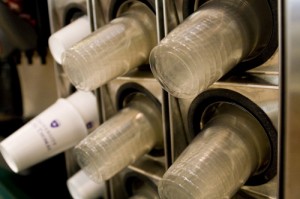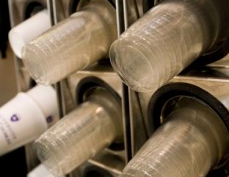
Decades worth of tradition are being tossed away by St. Thomas students this semester, and no one is doing a thing about it. In fact, St. Thomas actually approves of this historical overhaul.
Slowly but surely, the ever-present foam cups that have been a staple of St. Thomas eateries are becoming extinct in favor of a newer, more environmentally friendly model.
“We thought we’d join the club,” Director of Food Services Todd Empanger said. “The university’s mission is set up that way, so we’re just trying to follow that mission as best we can.”
The push toward being more eco-friendly means St. Thomas is going to let its supply of foam cups run out and replace them with new plastic cups, which are easier on the environment when broken down. The switch is gradual because St. Thomas buys cups in bundles of 50,000 and storage space is limited.
The new cups, which filtered in to all on-campus eating locations, including the Minneapolis campus, hit shelves late January.
“I never noticed it, I guess,” sophomore Peter Bussa said. “I know they had [foam] before … it’s saving money, I’m guessing?”
It’s actually the opposite. While the price increase isn’t monumental, the switch to plastic cups is costing the university “a few” more cents per cup, according to Empanger. He said he believes that is because it actually costs waste management facilities more to break down the multi-component plastic cups.
Despite their different appearance, the cups will be able to hold the same amount as their predecessors. But there will only be two sizes, instead of three, to choose from.
The change has been subtle and has gone mostly unnoticed, according to Empanger, but some students, such as junior Danny Kane, have recognized the switch and appreciate what St. Thomas is attempting.
“I think it is important,“ Kane said. “It’s a positive step to implement cups that can be recycled instead of being thrown away as the old cups were.”
Empanger said that the movement for new cups was more difficult than it seems. This was mostly because of all the facts and figures St. Thomas needed to take into account while listening to the pros and cons of prospective products.
“We get a lot of information,” he said. “It’s controversial. It goes back and forth between what’s right and what’s wrong [for St. Thomas].”
For example, the university looked into purchasing paper cups, but when those cups contained hot liquid, they got too hot for a person to hold. This meant the person would use another paper cup as a buffer, which added more waste.
Even with the new plastic model, hot liquids are a problem. If a person put hot coffee into one of the new cups, Empanger said that the cup would begin to weaken and melt.
While Empanger isn’t sure what the future has in store for the often-overlooked cups, he does know that whether students notice the change, the foam cups are gone for good.
Ben Katzner can be reached at bekatzner@stthomas.edu.


I do not fully agree that this issue has gone unnoticed; I think the problem is that students do not know what to do about it. The University states they want to save the environment when in fact the new cups cannot be recycled here at the university. I was explained to by the sustainability committee chair the other universities have the capable facilities of properly recycling this type of material, but St. Thomas does not recycle like other universities. “We run on our own schedule” is what I was told. And yes each cup may cost a few cents but think of the thousands of cups that we use every day, and they are all still ending up in the garbage. Therefore I believe that our university is increasing the cost of the cups but not decreasing the waste. The NatureWorks cups are indeed plastic 7 which is often the container of choice for reusable plastic water bottles, but we are not using them for re-use but one time uses. St. Thomas has been pushing environmentally friendly ideas on me heavily for years and wasting my money without even consulting the students being affected.
I’m sorry Jena, but I do not recall having made the statement attributed to me in your response. UST works with the non-profit Eureka Recycling who also handles all the recycling for the City of St. Paul. While Eureka does not curently collect this sort of cup for composting, they are investingating doing it in the near future. When they do, we will do what we can to assist Food Service in collecting the cups for composting. There are other universities who have large composting operations but not many in urban settings. Macalester until this year composted their food waste but that plan didn’t keep up with the volume and they are now using the same food recycler that UST has used for years. As far as students not being consulted, the use of environmentally favorable cups has been a concern and advocacy of UST students for at least 15 years. While we would like to keep cups out of the waste stream and look forward to the time when that is viable, please consider in the meantime decreasing the volume of recyclables that are being thrown by the UST community into thetrash. Trash audits have shown that 40 to 50 percent of what’s in UST trash cans could be recycled in the UST recycling program. We could and should do better.if there’s a concern about not wasting money